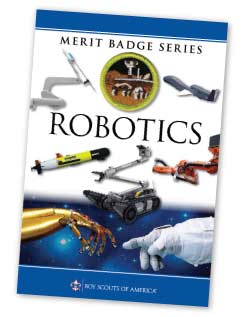
Go 'Bots
Scouting's newest merit badge animates engineering.
LAST OCTOBER, SIX MONTHS before the Robotics merit badge debuted, Rick Tyler could tell that the badge would be a hit. When the Seattle Scouter was testing merit badge requirements, 35 Scouts signed up for the 10 available slots—even though they knew they wouldn't get advancement credit and even though Robotics was competing with 20 or so other classes.
 "I think it's going to be a winner for the Scouts," said Tyler, who advises a robotics Venturing crew and served on the merit badge's development team.
"I think it's going to be a winner for the Scouts," said Tyler, who advises a robotics Venturing crew and served on the merit badge's development team.
He's undoubtedly right. What Scout wouldn't enjoy a badge that combines construction, competition, and a dash of science fiction?
Like many merit badges, Robotics includes requirements related to safety, general knowledge, and careers, but the heart of the badge is building a working robot or robotic subsystem. "Ninety percent of this merit badge is 'build a robot and write down what you do with your robot,' which we think keeps it fun," Tyler said.
Most Scouts probably will build their robots using kits from LEGO or VEX, the most popular robotics systems on the market. But the word "kit" is something of a misnomer, said Dr. Laszlo Hideg, a Chrysler engineer from Sterling Heights, Mich., who also served on the badge's development team. "Take an Erector Set and put it on steroids. That's a VEX system," Hideg said. "You have a lot of electric motors, sensors, wireless communication availability, and a small computer processor."
What Scouts build from those parts depends on their aptitude and interests. A typical robot might launch ping-pong balls, use an electromagnet to move metal objects, or navigate around a tabletop without falling off.
Both Tyler and Hideg said that it's O.K. for a pair of Scouts to work on a single robot as long as each individual Scout can demonstrate all of the requirements. Hideg stressed that each Scout should be involved in all aspects of the project—electrical, mechanical, and programming. Counselors should ensure that "all the Scouts would be able to look at the project and describe all of it," he said.
One way Scouts are supposed to describe their robots is through a robot engineering notebook, a journal of the design, construction, and testing phases. This process mirrors what working engineers do, partly to protect their inventions in case of intellectual-property disputes.
Staying safe is also important. The robots most Scouts will build aren't large enough to cause serious damage, but that doesn't mean cuts and pinched fingers aren't a possibility. "Like every shop teacher from the beginning of time, I point out how important it is to protect your eyes," Tyler said. "You only have two of them, and you don't grow new ones."
Robotics merit badge is challenging, but Tyler's October workshop convinced him that nearly all Scouts could complete it. "We really did have a random sample of Scouts in this workshop," he said. "Some of them obviously were 'A' students, and some of them obviously were not. But you know what? They all got through it, and they all did a pretty good job. This is not just a merit badge for rocket scientists."
Get Connected
With a special Web site that was scheduled to launch in April, Robotics merit badge became the first fully interactive merit badge in BSA history. You and your Scouts can check out boyslife.org/robotics to find how-to videos, expert advice, and sources for reduced-cost robotics kits.